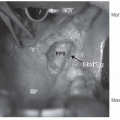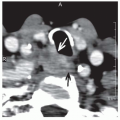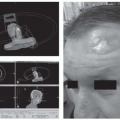Radiation Therapy Technique
Louis B. Harrison
James E. Dolan
Rudolph Woode
Waleed Mourad
Kenneth S. Hu
TONSIL
The chapter has provided extensive discussion about the relative indications for unilateral neck treatment versus bilateral neck treatment for patients with carcinoma of the tonsil. For unilateral treatment, either 3D conformal radiation therapy (3DCRT) or intensity-modulated radiation therapy (IMRT) can be used. Often, 3DCRT will allow the radiation oncologist to obtain excellent dose distribution with very acceptable normal tissue doses. The mere sparing of the contralateral neck and anatomical structures both reduces late toxicity and improves acute tolerance to treatment.
Figure 17-28 shows a patient with T2N0M0 squamous cell cancer of the left tonsil. As can be seen, excellent tumor coverage is obtained and key normal organs are well protected.
IMRT has been increasingly utilized for tonsil cancers. It is especially helpful in clinical situations where sparing of the contralateral parotid gland is appropriate or where the volume of normal tissue can be reduced with IMRT techniques. Figure 17-29 shows a patient with T1N0M0 squamous cell carcinoma of the right tonsil, treated with IMRT. The primary lesion receives the full therapeutic dose of 66 Gy in 33 fractions of 2 Gy each. The ipsilateral regional lymph nodes, including the ipsilateral lateral retropharyngeal nodes, receive elective nodal irradiation at 1.8 Gy/fraction. The contralateral neck and the contralateral parotid gland are spared. If there is a clinical indication to treat the contralateral neck electively (e.g., a primary lesion that extends within 1 cm of midline or involves the base of tongue, but the contralateral neck is clinically negative), then IMRT is used to keep the contralateral mean parotid dose ≤26 Gy (see technique for “Base of Tongue”). When IMRT is used, no bite block is used in order to maximize reproducibility and immobilization.
For patients with tonsil cancer and bilateral neck metastases, IMRT is used. The technique is similar for tonsil and base of tongue. Figure 17-30 shows a patient with cancer of the base of tongue and bilateral neck metastases. A similar technique would be used for a tonsil primary.
BASE OF TONGUE
Patients with cancer of the base of tongue (Fig. 17-31) are treated to the primary site and both sides of the neck. As discussed in the chapter, authors’ practice is to use an implant for the boost treatment. However, many centers do not incorporate brachytherapy and use an external beam boost.
IMRT is the standard approach for base-of-tongue cancers. Figure 17-31 shows the contours, dose distributions, and dose-volume histogram for a patient with T2N0M0 squamous cell carcinoma of the base of tongue. In this case, the primary site, as well as the bilateral neck nodes, receives 54 Gy in 30 fractions of 1.8 Gy. The contralateral parotid is relatively spared, as shown in the dose-volume histogram. However, because there are nodes near the parotid, the authors recommend caution about this. The low neck can be treated as part of the IMRT field or can be treated with a separate, anterior field, which also blocks the larynx in the upper midline. Treatment to the primary site is completed with an implant (Fig. 17-32). Figure 17-30 shows a patient with T4N2c squamous cell cancer of the base of tongue. This patient had disease extending into the upper portion of the larynx. An implant was not technically feasible, so IMRT was used for the entire course of treatment.
SOFT PALATE
Patients with soft palate cancer are treated to the primary site and both sides of the neck. As with base of tongue, there are no data to support the concept of ipsilateral neck irradiation in these patients. Techniques are similar to those for base of tongue.
Stay updated, free articles. Join our Telegram channel

Full access? Get Clinical Tree








